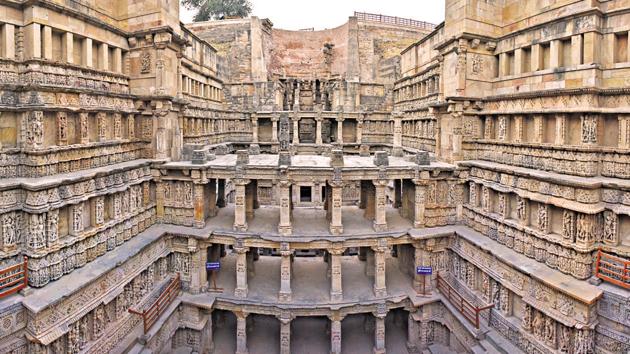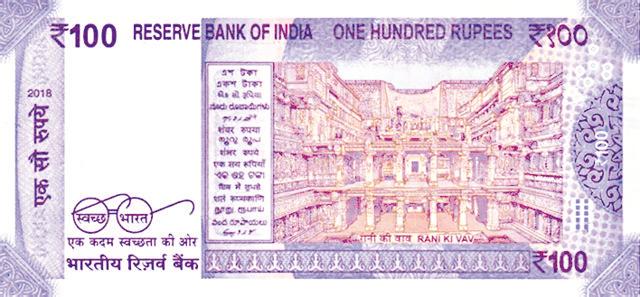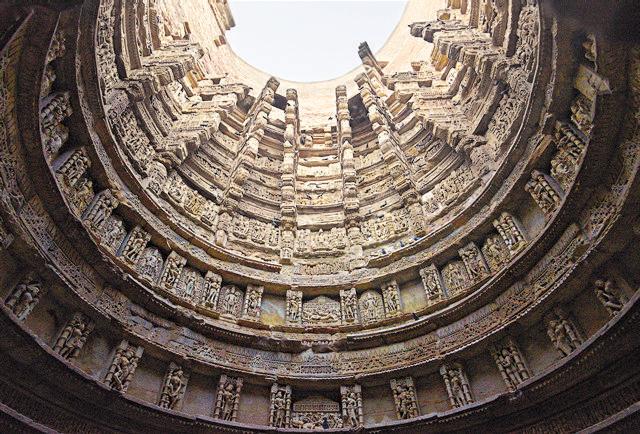Pride of Patan: The journey of Rani Ki Vav from being a buried art treasure to the reverse of the new ₹100 note
Rani Ki Vav, a stepwell in the little Gujarat town of Patan, features on the new Rs100 note. It was also declared a UNESCO World Heritage Site in 2014. But behind the recognition received by this monument is a story of recovery
On the wall behind the reception desk of a prominent hotel in Patan – one of a handful in this small Gujarat town – hangs a photograph of an ancient and ornate monument that could pass off as an old palace or temple. The same monument features in a series of promotional photographs in textile businessman Shyam Soni’s office and workshop – it is the backdrop against which several colourful saris are draped. For years, this monument has acted as Patan’s identity for the rest of the country and the world. But now Indians across the country will also carry its image in their wallets – albeit unintentionally and possibly, often without having spared it a glance.

Patan’s Rani Ki Vav – or the Queen’s Stepwell – replaces a view of the Kanchenjunga on the reverse side of the 100 rupee note issued by the Reserve Bank of India (RBI) recently. While the release of the new note was announced in July, it was only last month, in October, that it became easily available in the market. But though the new currency note does its best to depict “the country’s cultural heritage” as an RBI press release states, the motif of the Vav on the note is but a pale reflection of the majesty of the stepwell that had been lost for centuries beneath the sands of time. It was resurrected after decades of painstaking clearance and restoration by the Archaeological Survey of India (ASI) from 1958 onwards, and was declared a UNESCO World Heritage Site in 2014.

Built in the 11th century, Rani Ki Vav is popularly believed to have been buried underground owing to a flood in the river Saraswati, though opinion is divided on that. Some believe the Vav was simply silted up with the passage of time. In a region where several areas have traditionally had to deal with water scarcity, stepwells are not uncommon. But what sets Rani Ki Vav apart is its sheer size and fine craftsmanship. Measuring 64 metres in length and 27 metres in depth, it is a subterranean seven-storey structure, lavishly adorned with sculptures of gods, goddesses and other mythological and heavenly creatures that give it the look of a royal or divine abode.
“As a child, I would come here with my family on Diwali to offer prasad of sweet rice at the well,” says 72-year-old Patan local, Jayantilal Chimanlal Otia. “This was much before the ASI started work here. The top of the well was all that was exposed. We would draw water from there and drink, because it was believed that it could cure children of severe coughs. But we had no idea that there was so much more buried below,” he adds.
Capital Town
Like most of small-town India, Patan is an odd mix of the rundown and the glitzy, the old and the new. Boys who look too young to drive, ferry tourists in autorickshaws, even as burly mustachioed men drive camel carts through the town.
In the old town, where the Vav is, parts of the ramparts of what was once a fort are still visible. Locals believe the fort was built in one night by a spirit, Babra Bhoot, on the orders of one of the rulers of Patan. There are also ruins of old mansions, and giant darwazas or gates which once must have served as the entrance and exit points to and from the town.
The origin of the town dates back to the Chavda dynasty that ruled here. “Patan was once the capital of Gujarat. Vanraj Singh Chavda built Patan in AD 746,” says Jagdish Goswami, the lone guide at Rani Ki Vav. “The old name of the town was Anhilvad Patan. It is believed that Vanraj Singh had named the town after an animal herder, Anhil, who was probably his friend or had helped him in some way,” he adds.The Chavdas were succeeded by the Solanki dynasty, whose reign is believed to have been the “golden age of Gujarat”. An information box in the town museum states that “during these years (942-1244 AD), the city was a great place of learning and a prosperous trading centre. The rulers were great patrons of fine arts and architecture and undertook the construction of many civic and religious edifices in the city.”
One of these is Rani Ki Vav.
In Memoriam
Turning into old Patan, one is greeted with boards directing visitors to Rani Ki Vav or Rani Ni Vav as it is locally known.
“Rani Ki Vav was built by queen Udayamati, the wife of King Bhimdeva I of the Solanki dynasty, in the memory of her husband after his death. Generally kings make such monuments for their queens after their deaths. Here it is the opposite,” says Goswami. While popular history had always credited Udaymati for having built the Vav, Ravindra Singh Bisht, a retired ASI joint director-general, says historical research too has established her link with the stepwell. “During excavation a marble statue was found inside the Vav which had Maharajni Shri Udaymati inscribed on it,” he explains. A Jain scholar Merutunda, who composed the Prabandhachintamani, a chronicle of the kings of Gujarat, in 1304 AD, too recorded that Bhimadeva’s queen Udaymati caused to be built in the capital… a new step-well…”.
Descending into the Vav is like taking a trip in a time machine to an alternate reality, or being drawn in into a beautiful mirage, the spell of which breaks only after you resurface on the manicured lawns that now surround the heritage site.

The entire structure is made of sandstone. Stepped corridors lead around pillared pavilions or terraces, down to the reservoir (or tank). The well is beyond that. Both the walls of the Vav and the corridors are adorned with sculptures.
A Scottish team that did a digital documentation of the Vav in 2011 recalls on its website that the “sheer number of complex carvings was the major challenge” faced in the project. Vishnu – his different forms, avatars and swaroops – is the main subject of the sculptures. The walls of the well are adorned with carvings of Vishnu in various stages of repose. There are also sculptures of Vishnu with his wife Lakshmi, Shiva-Parvati, Brahma with his consort, Indra, Kuber, Hanuman and others. Then there are sculptures of Apsaras and Nagakanyas.
While some of the sculptures are in near-perfect condition, some have limbs missing, or facial features blurred with the effect of time, and the viewer has to place them in context to be able to identify them. Some of the niches and walls also have gaps – indicating the loss of some sculptures. The missing sculptures include three of the Vishnu avatars – Narsimha, Matsya and Kurma, thought it is unclear whether all three were originally there.
At the top of the steps, near the entrance, is a section of a column which is
believed to be the remains of the kirti toran – the ceremonial entrance to the Vav.
Clearing The Debris
It was in 1958 that ASI undertook the clearance and restoration work for the Vav, which was filled with silt and water. As the process of desilting and debris clearance started, the water also started receding. The silt had to be cleared bit by bit by hand and carefully checked before disposal for antiquities that could be mixed with the mud.
“It was the most risky project of my career,” says Bhopal-based retired ASI archaeologist Narayan Vyas, who did the documentation work at the site for seven years between 1981 and 1988 and also holds a PhD degree on the stepwell. “For days, I would sit on the narrow ledges that run along the walls on a chair working. If I looked down I felt dizzy, it was so deep,” he remembers.

Work was slow – the process took more than three decades to complete. Bisht recalls that when he had taken charge of the Indore circle (which includes Patan) in 1989, only three levels had been exposed. The rest was completed under him. The top two levels of the stepwell had been destroyed – ASI rebuilt them, but without any of the sculptural adornments that must have been there originally. After the desilting, the sculptures had to be cleaned with distilled water. “Chemical cleaning and treatment was done to protect the structure and sculptures,” says Vilas Jadhav, another retired ASI archaeologist who had also worked at the Vav.
Of course that hasn’t completely helped. “Since sandstone is very soft stone, the weathering effect is more,” says a local ASI official. Routine maintenance at the site is restricted to cleaning and taking care of tourist amenities, he says. “A former ASI chemist had found a way of strengthening sandstone by impregnating it with lime or some such cementing component. It could be tried at the Vav, to delay erosion,” points out Bisht.
For the time being, the representation of the Vav on the new currency note has filled locals with joy, as the UNESCO tag had done before. “We never thought this could be a tourist spot,” says 45-year-old Kirti Kumar Bhagwan Das Patel, with a laugh. “As kids we would play there. Now, there is a ₹40 entry ticket!”






